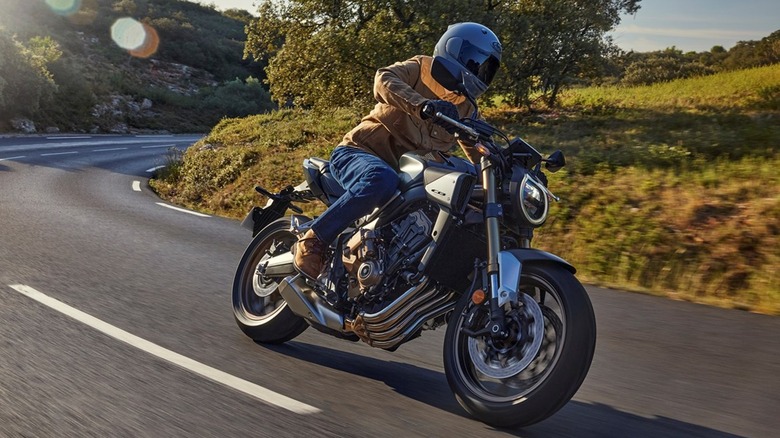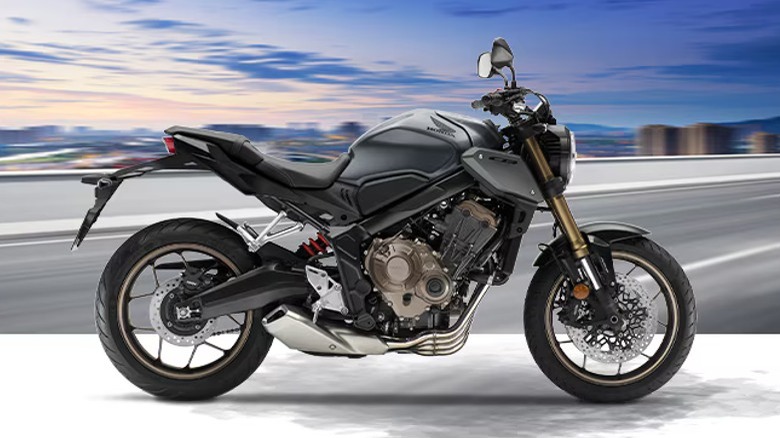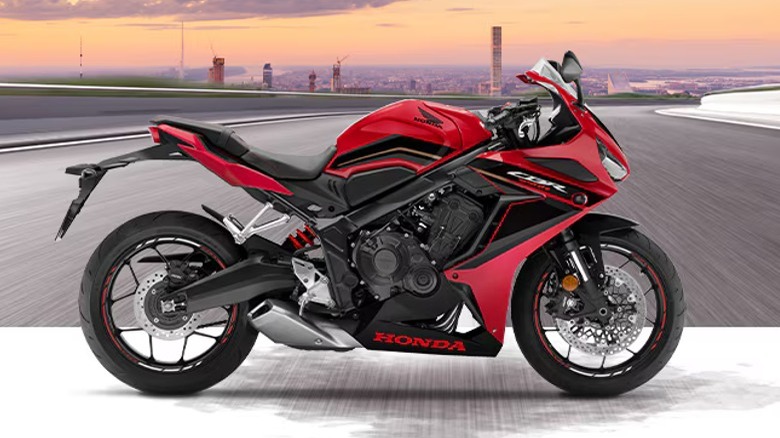Honda CB650 Vs CBR650 Motorcycles: What's The Difference?
Honda built its reputation on its street and sports bikes, and many enthusiasts consider it to be the best major motorcycle brand out there. Some riders want a general purpose bike for riding around town, while others might be more interested in a performance-oriented bike that can outrun and outmaneuver the competition. Knowing this, Honda needs to be able to make different kinds of motorcycles to suit their needs. This is likely why it has a few bikes in its product lines that have nearly identical spec sheets, but are designed to accommodate different styles of riding.
Take the Honda CB650R and the Honda CBR650R, for instance. Two bikes running on the exact same 649cc liquid-cooled in-line four-cylinder engine, right down to the DOHC four-stroke valve train, 67mm bore, 46mm stroke, 11.6:1 compression ratio, and 6-speed transmission. Even beyond the engine, the bikes have the same twin-spar steel-tube chassis, the same wheels, the same slipper clutch, and several other features besides.
Models from both the CB and CBR lines have been counted among the best motorcycles Honda has ever made. So, with only a single letter in the name to separate them, it's easy to see why telling them apart might be confusing on paper. These bikes actually have significantly different designs, however. A single glance is all it takes to tell that they are entirely different kinds of motorcycles.
The Honda CB650R is a naked street bike
Different kinds of motorcycles excel at different kinds of riding. Touring bikes, for instance, are designed to be more comfortable for long-distance road trips, while adventure bikes are designed to handle just as well in off-road conditions as they do on the highway. Naked street bikes like the Honda CB650R are designed for urban riding. They're typically comfortable, affordable, easy-to-ride, low-maintenance, and offer above-average cornering and acceleration performance. This makes naked street bikes into all-rounders that are great for everyday commutes and short rides around town.
The CB65R has a stripped-back design with no fairing over the engine, allowing the machinery to be fully exposed. This is largely an aesthetic choice, and gives the machine a slightly narrower profile. It also has taller handlebars, which allow you to sit in a more upright position. This is more comfortable, but it comes at the cost of increased wind resistance when riding at higher speeds. It has 0.8 inches more ground clearance than the CBR and a slightly smaller rake angle, which may mean sharper handling. The CB650R also has some more modern café design elements, such as its rounded LED headlight, which help visually separate it from the CBR650R.
The Honda CBR650R is a sports bike
Street bikes are great for a casual commute, but they aren't the vehicles with the best performance on two wheels. That honor goes to sportsbikes. This is the category that holds the Honda CBR650R. These vehicles typically sacrifice comfort and fuel economy for superior acceleration, speed, cornering, and overall handling. Sports bikes are also good for urban riding, but they are designed for riders who like to spend their weekends navigating winding side roads or else at the racetrack pressing their bike to its limits. If that means putting a little extra pressure on their lower back in the name of performance, so be it.
That said, the shape is really the only thing separating the CBR650R from the CB650R. The sportsbike has the full fairing enclosure and dual-lens LED headlight that are common among the vast majority of modern sports bikes. Its handles are much lower and narrower, making turning more responsive and placing the rider in a much more forward-leaning position, which decreases wind resistance. Even so, both bikes share the same engine, and both are reported by Honda to weigh exactly 445 lbs. (though CycleWorld reported a 3 lb. to 4 lb. difference between regular and e-clutch models and claimed that the CBR was around 10 lbs. heavier.) There is also no reported difference in torque, horsepower, or maximum speed. This means riders shouldn't expect as much of an increase in overall performance as you would usually look for in a sports bike.


